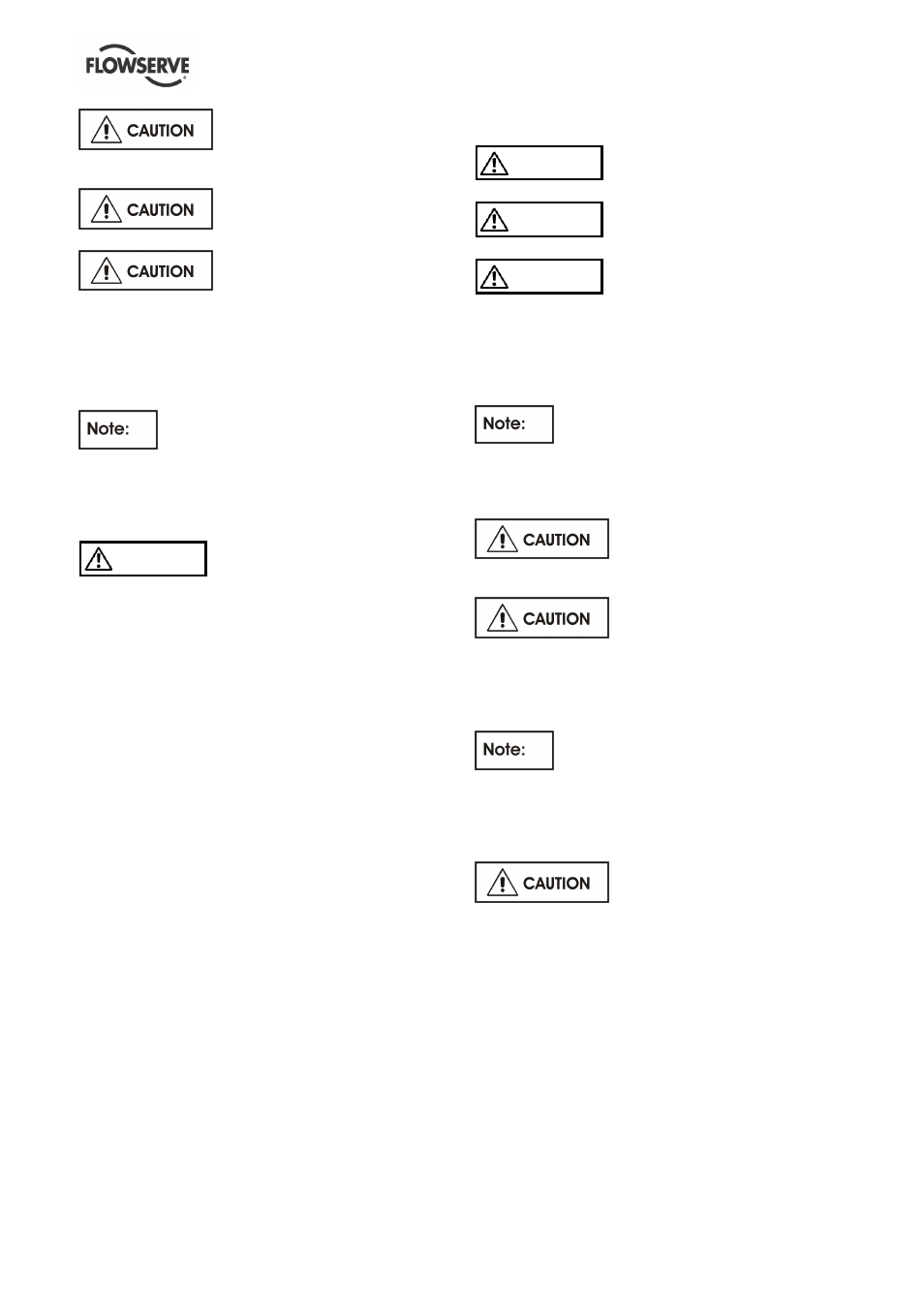Flowserve MSP User Manual
Page 28

MSP USER INSTRUCTIONS ENGLISH - 07/14
Page 28 of 35
Open the Block & Bleed valve to
allow proper function of the PSH (set point 0.5 bar
(7.25 psi) above flare pressure).
Open all necessary valves in the
cooling and auxiliary piping and check the flow.
Disassembly of the seal cartridge
is only allowed by authorized personal. Contact
Flowserve for any service of the mechanical seal. We
recommend to have a spare cartridge seal on stock
for easy replacement.
7.1.6 Dual Mechanical Seal pressurized with
API–Plan 53a
Refer to mechanical seal drawing and
auxiliary piping drawing.
The pump is equipped with a dual mechanical seal in
face to back configuration, back to back configuration
or face to face configuration.
CAUTION
Try to turn the rotor by hand.If the
rotor cannot be turned, the pump must be
disassembled, refer to section 6.7.1 Dismantling
MSP.
The mechanical seal requires no adjustment
anymore. Check if the mounting plates are already
swung out.
Actions after start up:
Check all connections to the seal gland and the
mechanical seal itself against leakage. Check the
temperature of the seal gland. I slight increase of
temperature may be observed during the run in
period.
Plan 53 pressurized dual seal systems are used in
services where no leakage to atmosphere can be
tolerated. A Plan 53a system consists of dual
mechanical seals with a liquid barrier fluid between
them. The barrier fluid is contained in a seal pot
which is pressurized to a pressure of approximately
1.5 bar (23 psi) greater than the pump seal chamber.
Inner seal leakage will be barrier fluid leakage into
the product. There will always be some leakage
(max.5 ml/hour).
The leakage rate is monitored by monitoring the seal
pot level. The product must be able to accommodate
a small amount of contamination from the barrier
fluid. The seal pot pressure must be maintained at
the proper level. If the seal pot pressure drops, the
system will begin to operate like a Plan 52, or
unpressurized dual seal, which does not offer the
same level of sealing integrity. Specifically, the inner
seal leakage direction will be reversed and the barrier
fluid will, over time, become contaminated with the
process fluid with the problems that result, including
possible seal failure.
CAUTION
Fill the seal system with a suitable
barrier buffer fluid (refer to lubrication table).
CAUTION
Open all necessary valves in the
cooling and auxiliary piping and check the flow.
CAUTION
Disassembly of the seal cartridge
is only allowed by authorized personal. Contact
Flowserve for any service of the mechanical seal. We
recommend to have a spare cartridge seal on stock
for easy replacement.
7.1.7 API Plan M
Refer to auxiliary piping drawing.
The pump is equipped with an API plan M, cooling to
seal heat exchanger.
Open all the valves in the cooling line before start up
the pump.
Check cooling flow at the
installed flow indicator. If required adjust flowrate with
the flow control valve.
Refer to the GA - drawing for the
required cooling flow and pressure.
7.1.8 Dual Mechanical Seal pressurized with
API–Plan 32+54
Refer to mechanical seal drawing and
auxiliary piping drawing.
The pump is equipped with a dual mechanical seal in
face to back configuration, back to back configuration
or face to face configuration.
Try to turn the rotor by hand.If the
rotor cannot be turned, the pump must be
disassembled, refer to section 6.7.1 Dismantling
MSP.
Actions after start up:
Check all connections to the seal gland and the
mechanical seal itself against leakage. It is usual that
at the seal faces a small leakage occurs after start
up, which decreases with the time of operation and
should stop after the seal is run in. Check the
temperature of the seal gland. I slight increase of
temperature may be observed during the run in
period.
The mechanical seal is flushed by an API Plan 32
and the temperature at the seal gland should be max.
10 °C (18 °F) above the pumped liquid temperature,
